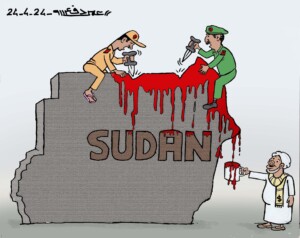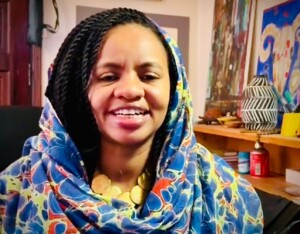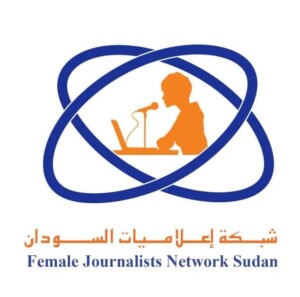Op-ed: Security Arrangements in Sudan – Achilles heels of peace and democratic transformation
This article is intended to act as an eye opener for all the Sudanese political forces. It aims to shed light on the huge challenges that will be faced by the December transitional government in concluding a peace agreement(s) whose aim will be to end the war and achieve a comprehensive and permanent peace in the country.
 The opening session of the third round of Sudan peace talks in Juba last week (RD)
The opening session of the third round of Sudan peace talks in Juba last week (RD)
By Dr Elwathig Kameir
This article is intended to act as an eye opener for all the Sudanese political forces. It aims to shed light on the huge challenges that will be faced by the December transitional government in concluding a peace agreement(s) whose aim will be to end the war and achieve a comprehensive and permanent peace in the country.
Indeed, this is a necessary prerequisite if there to be a peaceful transition of power through free and fair elections at the end of the 3-year transitional period. In fact, general elections cannot take place, nor can the democratic transition be completed, without the inclusion of the armed resistance forces and, their eventual transformation into civil-political entities, thus ensuring the participation of all the Sudanese in the war-affected regions. I contend in this paper that, apart from the challenges of reaching an agreement on the political issues of the peace negotiations agenda, including the humanitarian question, the issue of the security arrangements remains par excellence the Achilles heel of peace and democratic transformation. Equally, it is important to note that resolving the issue of comprehensive security arrangements is the key to achieving security and stability in all parts of the country, the safe return of displaced persons and refugees to their homes, on the one hand, and a main entry point to the process of removing the country’s name from the list of states sponsoring terrorism, on the other hand. It is well known that terrorists and nefarious forces infiltrate countries that lack security and a national army that defends and protects the state’s sovereignty and, territorial integrity.
For an in-depth understanding of the complexity of security arrangements, intertwined with political and humanitarian issues, it is imperative to situate the matter in the overall context of the upcoming round of negotiations scheduled for 10th December 2019. Of course, this requires consideration of the respective positions of both the transitional government and the armed movements with regards to the peace process. However, apart from according ending the war and building peace a priority in the transitional constitutional document, and making reference to a Peace Commission as a mechanism for realizing this objective, it seems the transitional government lacks a clear vision, strategy or practical plan that could be translated into a coherent negotiating position. This ambivalent situation is likely to lead to a conflict of competence between the Council of Ministers and the Sovereign Council, and their respective constituencies.
In pursuit of the same old approach of successive post-independence regimes, the transitional government has embarked on a two-track negotiations with the armed movements during October 2019, in Juba. A Declaration of Principles was signed between the government and the Sudanese Revolutionary Forces Front (SRF), while a short pre-negotiations agreement (roadmap) was reached between the government and the SPLMN under the leadership of Commander Abdelaziz al-Hilu. It was agreed in both tracks to resume negotiations on 21st November 2019, later postponed to be reconvened in Juba, on 10th December 2019. My analysis of the issue of security arrangements, and its implications for the twin peace and democratization processes, will be confined in this article to the negotiating position of the SPLM-North under the leadership of Lieutenant General Abdelaziz al-Hilu.
Two major obstacles have stood in the way of a peace agreement, and have perpetually threatened all rounds of negotiations between the NCP government and the SPLM-North (SPLMN) since the signing at the end of June 2011 of the framework agreement known as the “Malik-Nafie Agreement”, and until the last round in January 2018 in Addis Ababa. The first obstacle was the divergence of positions on the “inclusiveness” of the negotiating agenda between the two parties as regards both the scope and the expected outcome of the negotiations. While the SPLMN calls for the inclusion of national constitutional issues in the agenda, the government insists on restricting negotiations to the Two Areas (South Kordofan/Nuba Mountains and Blue Nile states).
The second, and perhaps most important, obstacle is the conditions and modalities of ensuring cessation of hostilities leading to a permanent ceasefire and comprehensive security arrangements. Each party has its own contradicting vision and strategy of prioritizing the agenda and issues of negotiation. In the opinion of the NCP government, the issue of comprehensive security arrangements should be resolved first, even if the pace of negotiations on political issues is lagging. While, for the SPLMN the utmost priority lies in reaching a comprehensive political agreement, which includes a text recognizing the “autonomy/self-rule” of the Two Areas. Of course, this was the Movement’s position before the extraordinary National Congress of the SPLMN, under the leadership of Lieutenant General Abdelaziz al-Hilu.
Against this backdrop, the outcome of the Juba Agreement, the roadmap, between the government and the SPLMN has come a long way in overcoming the obstacle to the arrangement and sequencing of the negotiation issues, which twenty earlier rounds of negotiations had failed to resolve i.e. starting the negotiations with the political issues and ending with the security arrangements.
Although the agreement did not elaborate on the nature and details of the political issues, both national and specific to the Two Areas, however, there is no doubt that the SPLMN will raise the issues of “secularism” vs the right to self-determination, in addition to other issues, including the question of cultural identity, marginalization, and the system of governance. Notwithstanding the ensuing debate, as to whether or not self-determination is a politically realistic option, it should be noted this right is not a new claim in the Two Areas, but dates back to the first half of the 1990s. Since the Abuja II negotiations in 1993, the position of the SPLM/A has been calling for the three “transitional” regions: Southern Kordofan, Blue Nile and Abyei, either to be part of a new secular, democratic Sudan, or to grant their people the right to vote with the Southerners for a confederal state with Southern Sudan. Again, the Two Areas were excluded from the Machakos Protocol, which recognized the right of self-determination for South Sudan only. However, during the CPA negotiations in 1998, the leaders of the SPLM/A in both areas, namely Commander Yousif Kuwa Mekki, insisted that were the Southerners to vote for separation, the people of the Two Areas would have three options: to be part of either the state of South Sudan, or North Sudan, or establish their own independent state.
The CPA denied the people of South Kordofan and the Blue Nile the right to self-determination, while offering them as an alternative a process called “popular consultation” as a mechanism that would allow people to decide whether the agreement is addressing their grievances sufficiently, through the Legislative Councils in the two states. However, the process which was rather ambiguous failed to achieve the desired results as the consultation process in Blue Nile was not completed, and it never took off in South Kordofan. Thus, this illusionary outcome disappointed large segments of the population in the Two Areas who felt that their identity, land and political destiny had gone with the wind, until the war broke out again in the Two Areas in June and September 2011, respectively. The SPLMN Extraordinary National Convention, under the leadership of General Abdulaziz al-Hilu, adopted in mid-October 2017 the right to self-determination. This was enshrined in the Movement’s manifesto as “the right of all Sudanese peoples to exercise their rights, either for full independence or agreement on a secular democratic system of government” in the whole country.
In my opinion, this is one of the most important resolutions of the SPLMN Extraordinary Convention, leaving little room for its leadership to renege on such a unanimously approved resolution. The SPLMN leadership are therefore obliged to put it on the negotiations’ table and work towards its achievement. It is, thus, imperative for all political forces not to be captivated by the obsession of repeating the experience of South Sudan, but rather should concern themselves with responding to the fundamental question: Why have calls for self-determination been incessantly and repeatedly raised in some parts of Sudan since the eve of the country’s independence in 1956?
Therefore, a serious question poses itself: Will the government merely dismiss and deny the right of self-determination, and the separation of religion from the state issues, on the pretext that the claim to these rights originated during the era of the NCP’s tyrannical and authoritarian regime that was overthrown by the December revolution and do not therefore merit consideration? Or, even further that the time is not yet opportune to raise the matter due to the transitional nature of the government, whose limited mandate does not allow it to dwell, and make decisions on major national and constitutional issues, and thus the debate over these issues should be deferred to the upcoming Constitutional Conference? In fact, some leaders of the Forces of Freedom and Change (FFC), including the SRF, have publicly expressed this view on several occasions. Therefore, if the government does not accept the inclusion of these issues in the Declaration of Principles governing the negotiating process, then what political issues will be negotiated?
In my opinion, such an approach signifies returning to the same initial obstacle, which had stood in the way of reaching a peace agreement with the NCP regime, by restricting negotiations only to issues pertaining to the two regions, provided that the national constitutional issues be discussed in the “national dialogue” called for by the ousted president at the beginning of 2014. However, despite the adoption of this dialogue by the African Peace and Security Council, all attempts of the African mediation (The African Union High Implementation Panel), including preparatory meetings and the design of a roadmap, in its various versions, failed to bring the armed resistance forces to the “leap” dialogue, thus negotiations were completely suspended.
In my open letter to the Prime Minister (September 2019), I wondered whether it was politically realistic to combine both the Peace Commission and the Constitutional Conference in one commission? Why not hold the Constitutional Conference at the beginning of the transitional period rather than relegate its convocation to the end of that period? Indeed, the Koka Dam Declaration, of March 1986, called for this conference to be held after less than four months during the third week of June 1986, with the consent of the SPLM/A, under the leadership of the late John Garang, to participate in an interim national unity government.
Now, the call to defer the war and peace issues, primarily of a national and constitutional nature, to the Constitutional Conference, which is scheduled to be held – according to the Constitutional Document – at the end of the transitional period, can only mean stalling the agreement on a permanent ceasefire, and comprehensive security arrangements, for years to come. Beyond that, how would the SPLMN be prepared to participate in the elections that are supposed to be held immediately after the conclusion of the Conference? The general elections did not take place in 2010 until after the signing of the six protocols of the CPA, especially the security arrangements protocol that retained the SPA, whose fate was left to the outcome of the referendum on self-determination. Or, are we destined to reproduce our past experiences, by denying the people in the war-affected areas their constitutional right of casting their votes, while leaving the peace negotiations to the elected government, thus entering a new vicious cycle? If so, what difference did the December revolution really make?
In my opinion, the SPLMN, under the leadership of Commander Abdelaziz al-Hilu, even in the case of sitting with the government to only negotiate issues specific to the Two Areas, will adhere to preserving the SPLA as an armed force until they are assured of the implementation of what has been agreed upon.
Security Arrangements: Is there Light at the End of the Tunnel?
Therefore, the negotiating position of the SPLMN has consistently remained that the issue of security arrangements should not be discussed, prior to the political issues (addressing the roots of the crisis according to the speech of Abdelaziz al-Hilu to the opening session of the negotiations in Juba on October 14), which is exactly the “sequencing” that was endorsed in the Juba agreement with the transitional government. Far from being a reflection of provocative bellicosity, the SPLM’s position on security arrangements has its genesis back in the first civil war and the absorption of Any Nya II forces in the Sudanese Army, according to the Addis Ababa Peace Accord, in 1972, which later reignited the war in 1983.
This integration process weakened the position of Southern politicians and made them vulnerable in facing President Nimeiri’s manipulations, thus enabling him to overturn the provisions of the agreement that he weaved with his own hands. Thus, following the formation of the SPLA, the original thesis of the late Dr. Garang aimed at destroying the Sudanese Armed Forces (SAF) and, in the process, replacing it with an army that fits the particularities of the New Sudan. In the evolution of the struggle against the NIF-NCP regime, however, this proved to be both untenable and unrealistic, thus he resigned himself to a politically negotiated settlement. Therefore, the CPA introduced the Joint Integrated Units (JIUs), as a mechanism for merging the SPLA and SAF, to serve as a nucleus for Sudan’s National Army in case the South Sudanese opted for unity.
It is worth noting that the SPLMN has had a bitter experience in the Two Areas that calls for utmost caution before delving into any security arrangements this time. Indeed, the CPA, both in design and implementation, has not adequately addressed the challenges and causes of conflict in the Nuba Mountains, and Southern Blue Nile. This is the main reason behind the resurgence of violence and the menace of a new civil war in the Two Areas in 2011. Thus, the SPLA, as per the terms of the CPA-Protocol on Security Arrangements, is unambiguously defined as an indivisible whole that belongs to South Sudan, and not subject to disaggregation by origin of combatants i.e. whether they hail from South Kordofan or Blue Nile. Therefore, the Agreement was mute on, and made no reference to the fate of thousands of non-JIUS fighters from the Two Areas stationed with their mother units of the SPLA in the South.
In light of the failure to fulfill the time ceilings of the agreement and the political entitlements of the Protocol on the Two Areas, to pave the way for completing the process of comprehensive security arrangements, the NCP government threatened to forcibly disarm the SPLA if they refused to deploy their forces to the South. This predicament resulted in a new civil war in both regions by mid-2011. Furthermore. The issue of the popular army was like the straw that broke the camel’s back of the SPLMN, as it was one of two main underlying reasons for the split in the leadership of the Movement after the resignation of its then deputy chairman, Commander Abdelaziz al-Hilu, in March 2017. Al-Hilu objected to the draft “Agar/Nafie” Framework Agreement, June 28, 2011, due to the provisions of the security arrangements, which in his opinion aimed, at “absorbing the SPLA/N into the army of the National Congress,” as he put it in the text of his resignation.
For that reason the SPLM/A, in addition to any constitutional and legal guarantees that would be embedded in the agreement and, regardless of pledges made by regional and international observers to secure the implementation of the Agreement, was also firm in their demand of preserving the SPLA to ensure the implementation of any peace agreement. John Garang strongly believed that the only credible guarantee for any agreement would be one that affords him leverage in the process of implementation, or what he called the “organic guarantee”.
Therefore, my opinion is that the change of the ruling political regime, and the fact that the NCP has been dissolved, following the December revolution and the formation of the transitional political institutions, might not be sufficient to serve as guarantees necessary for the SPLMN to abandon the SPLA throughout the transitional period, unless they receive assurances of the full implementation of the provisions of any peace agreement to be reached with the Khartoum government. That is, especially in light of the presence of multiple armies, military formations, and militias, on both sides of the government and armed resistance movements, unlike the situation in October 1964 and April 1985. Such a predicament calls for the political will and willingness of all parties to build a unified national army, as a single national institution that monopolizes violence in the Sudanese state, and that is entrusted with defending the territorial integrity of the country, in tandem with an agreement that addresses the comprehensive reform of the entire security sector.
In this respect, a number of important questions remain, that search for answers in order to conceptualize the conditions conducive to achieving the desired peace by uniting and/or integrating all the forces that bear arms. First, is there harmony and agreement between the Sudan Armed Forces, as an entity, and the Rapid Support Forces (and other parallel forces), or is it only the conditions and circumstances of the December revolution that imposed their coming together in holding the reins of power, while each party is obsessed with, and questioning the intentions of the other? Second, to what extent do all the armed movements have actual forces on the ground and occupy territories outside of government control? If all the above is true, to what extent can this multiplicity of forces accept integration or unification within the armed forces, or demobilization and reintegration?
All the Sudanese political forces, and the armed forces, whether on the side of the government or that of the armed resistance movements, should bear their respective historical responsibilities and demonstrate a genuine will to agree on the most appropriate formula or mechanism to build a single unified Sudanese armed force, whose presence is felt by all the people of Sudan, and which acts as a mirror where all see themselves reflected. History tells us that there is no place in it for a viable state without a cohesive national army, which is capable of defending its citizens and protecting the constitution of the country.
Conclusion
Peace has always been at the forefront of the concerns and political agenda of both the transitional revolutionary governments that followed the popular uprisings of the Sudanese people, in October 1964 and April 1985, perhaps unlike the parliamentary and military governments. Sudan’s first serious attempt to seek peace under the auspices of the October transitional government in 1965 failed miserably, with the collapse of the “Round Table” conference after the “Northern” political forces rejected the demands of the South Sudan’s leaders, and called for early elections before the end of the transitional period. The same scenario was repeated after the success of the popular uprising, in March/April 1985, when both the revolutionary government, perhaps due to the short transition period, and the subsequent parliamentary regime, were unable to implement the resolutions of the Koka Dam Conference, of March 1986. These resolutions represented an important breakthrough in the path of peace and provided a great opportunity for translating them into action. However, this opportunity was not adequately seized by the country’s political leadership, thus the hopes of the “Intifada” forces evaporated, and the civil war continued for another twenty years.
Unfortunately, the December transitional government has not deviated from the record of its predecessors in assigning a priority to and placing putting an end to the war, and achieving peace, at the top of its program agenda. Neither of the previous two transitional revolutionary governments succeeded in reaching a peace agreement with the Anya Aniya movement in 1964, or the SPLM/A in 1985. However, at least in both cases they succeeded in ending their transition with general elections, thus relegating the question of war and peace to the elected governments. However, this approach has equally failed in stopping the war, but instead its geographical spread widened further. Therefore, all the general elections that followed the two transitional periods ended up not being inclusive, as the inhabitants of the war-affected areas were denied their right of participation, and were thus deprived of equitable representation in the national state institutions of the country, whether in the public service or in SAF or the other regular forces. In the wake of the December revolution, given the enormous sacrifices incurred, the Sudanese people are now aspiring to a peaceful transition of power through inclusive, free and fair elections that would avoid reproducing the failed experiences of the past.
I conclude that the feasibility and sustainability of peace is contingent, on the one hand, on the extent to which the armed resistance movements are capable and actually do transform themselves into civilian political organizations, prepared for participation in the general elections at the end of the transitional period. On the other hand, sustainable peace will depend on the willingness of the various armed forces to receive new arrivals as comrades in arms, thus opening the door to a permanent ceasefire and comprehensive security arrangements and building a united national army within a framework of a holistic and well-planned reform of the entire security sector. Without such an arrangement, we will inevitably return to square one, if not the entire country will fall into an abyss. Security arrangements are the Achilles heel of peace and democratic transformation. Is the December Revolution capable of making a difference this time?
Disclaimer: The views and opinions expressed in this article are those of the contributing author and do not necessarily reflect the position of Radio Dabanga.
 Dr Elwathig Kameir is now based in Toronto, Canada. He was a Lecturer and subsequently Associate Professor, 1980-1990, Department of Anthropology and Sociology, Faculty of Economic and Social Studies, University of Khartoum, where he taught various courses on sociology and development, conducted research, participated in consultancy work and produced several publications.
Dr Elwathig Kameir is now based in Toronto, Canada. He was a Lecturer and subsequently Associate Professor, 1980-1990, Department of Anthropology and Sociology, Faculty of Economic and Social Studies, University of Khartoum, where he taught various courses on sociology and development, conducted research, participated in consultancy work and produced several publications.
Since 1990, he has been working as a freelance consultant and carried out a number of assignments for regional and international organisations, including the ECA, AfDB, Arab League, ILO, UNICEF and UNESCO.
Dr Kameir worked as a Senior Program Specialist with the Canadian International Development Research Centre (IDRC) at the Regional Office for Middle East and North Africa, based in Cairo (1999-2005). He actively participated in the African and Arab research community and held leading positions in respective professional and academic associations. He was member of the Board of Trustees of the Arab Association for Sociology (1984-1990), and Vice President of the Organization of Social Science Research for Eastern and Southern Africa (OSSREA), 1993-1996.
Dr Kameir has maintained close affiliation with the Sudan People’s Liberation Movement (SPLM) and had close working relations with the Movement’s late Chairman, Dr John Garang de Mabior. He coordinated the Ambo workshop in February 1989 that brought together leaders of the SPLM with intellectuals and trade union activists from North Sudan. He edited and introduced a book on the Vision of the New Sudan, published both in Arabic and English. Dr Kameir has also published a number of articles on the politics of the SPLM, and the current political developments, following the separation of the South, in the SPLM-North.
Radio Dabanga’s editorial independence means that we can continue to provide factual updates about political developments to Sudanese and international actors, educate people about how to avoid outbreaks of infectious diseases, and provide a window to the world for those in all corners of Sudan. Support Radio Dabanga for as little as €2.50, the equivalent of a cup of coffee.












 and then
and then